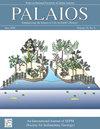MEDITERRANEAN IMPRINT ON CORAL DIVERSITY IN THE INCIPIENT RED SEA (BURDIGALIAN, SAUDI ARABIA)
IF 1.5
4区 地球科学
Q2 GEOLOGY
引用次数: 0
Abstract
Globally, scleractinian coral diversity peaked in the Early Miocene (Burdigalian) and declined afterwards. In contrast to this global trend, scleractinian coral diversity in the Lower to Middle Miocene was low in the Red Sea, which had begun to open in the Oligocene and experienced its first marine incursion in the Burdigalian. Here, we report on coral diversity of reefs assigned to the Burdigalian to Langhian Wadi Waqb Member (Jabal Kibrit Formation) from outcrops exposed in the foothills behind the Red Sea coastline near Umluj, Saudi Arabia. Compared to the global records from the Paleobiology Database and the literature, the fossil record from the Wadi Waqb member suggests a relation of the taxonomic spectrum to the Arabian Gulf and the Mediterranean. No clear relation to the taxonomic spectrum to the Indian Ocean is observed. These faunal differences are consistent with the hypothesis that the young Red Sea was connected to the Arabian Gulf via the Mediterranean through the Gulf of Suez, but there was no connection between the Red Sea and the Indian Ocean because of the Afar mantle plume that uplifted the southern area of the Red Sea rift and blocked direct exchange of marine biota.初生红海(沙特阿拉伯布尔迪加里安)珊瑚多样性的地中海印记
在全球范围内,硬骨珊瑚的多样性在早中新世(布迪加里纪)达到顶峰,之后逐渐下降。与这一全球趋势相反,红海在下中新世的硬骨鱼类珊瑚多样性很低,红海在渐新世开始开放,在布迪加里纪经历了第一次海洋入侵。在此,我们报告了沙特阿拉伯乌姆卢杰附近红海海岸线后山麓出露的珊瑚礁的珊瑚多样性,这些珊瑚礁被归入布迪革伦至朗格安时期的瓦迪瓦克布层(Jabal Kibrit Formation)。与古生物学数据库和文献中的全球记录相比,Wadi Waqb 成员的化石记录表明其分类谱系与阿拉伯湾和地中海有关。没有观察到分类谱系与印度洋的明显关系。这些动物群的差异符合以下假设:年轻的红海通过苏伊士湾与地中海相连,但由于阿法尔地幔羽流抬升了红海裂谷南部地区,阻碍了海洋生物群的直接交流,因此红海与印度洋之间没有联系。
本文章由计算机程序翻译,如有差异,请以英文原文为准。
求助全文
约1分钟内获得全文
求助全文
来源期刊

Palaios
地学-地质学
CiteScore
2.80
自引率
12.50%
发文量
40
审稿时长
6 months
期刊介绍:
PALAIOS is a monthly journal, founded in 1986, dedicated to emphasizing the impact of life on Earth''s history as recorded in the paleontological and sedimentological records. PALAIOS disseminates information to an international spectrum of geologists and biologists interested in a broad range of topics, including, but not limited to, biogeochemistry, ichnology, paleoclimatology, paleoecology, paleoceanography, sedimentology, stratigraphy, geomicrobiology, paleobiogeochemistry, and astrobiology.
PALAIOS publishes original papers that emphasize using paleontology to answer important geological and biological questions that further our understanding of Earth history. Accordingly, manuscripts whose subject matter and conclusions have broader geologic implications are much more likely to be selected for publication. Given that the purpose of PALAIOS is to generate enthusiasm for paleontology among a broad spectrum of readers, the editors request the following: titles that generate immediate interest; abstracts that emphasize important conclusions; illustrations of professional caliber used in place of words; and lively, yet scholarly, text.
 求助内容:
求助内容: 应助结果提醒方式:
应助结果提醒方式:


